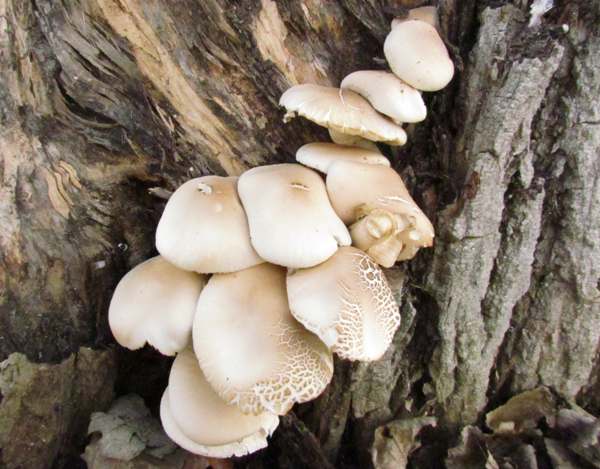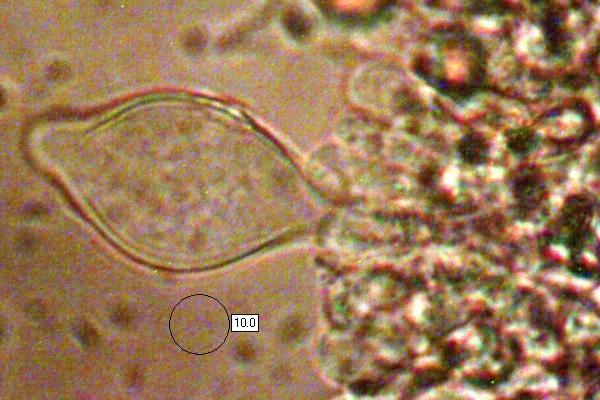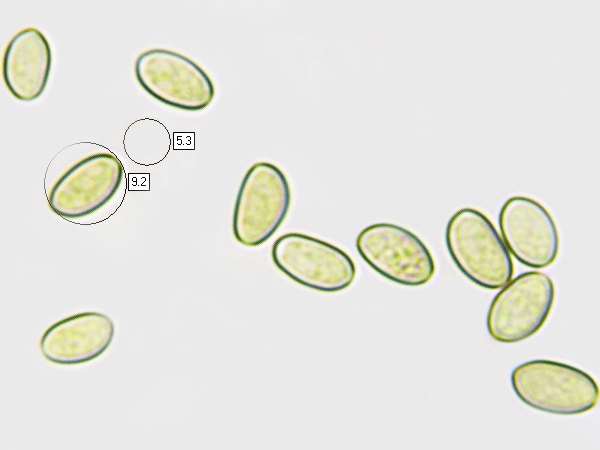Cyclocybe cylindracea (DC.) Vizzini & Angelini - Poplar Fieldcap
Phylum: Basidiomycota - Class: Agaricomycetes - Order: Agaricales - Family: Strophariaceae
Distribution - Taxonomic History - Etymology - Identification - Culinary Notes - Reference Sources
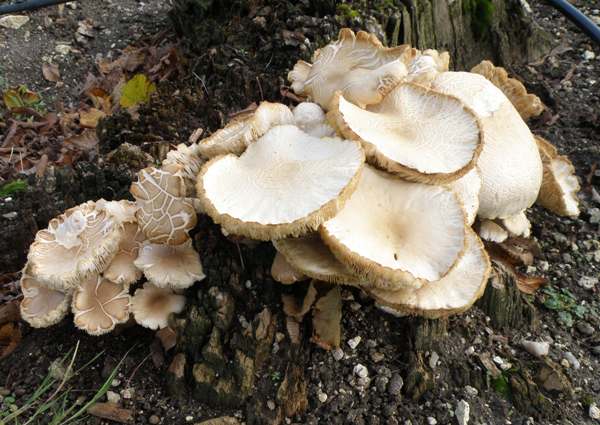
Most other fieldcaps seem to know where the fields are, but the Poplar Fieldcap is a bit of a rebel and fruits on dead poplar stumps. Despite its common name, this mushroom also occurs on willow in damp woods and coppices.
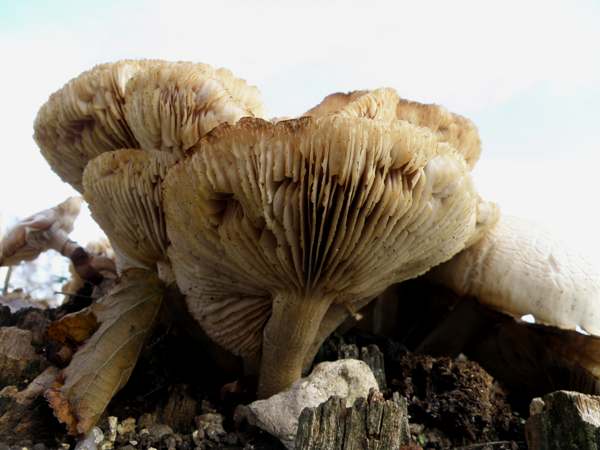
Distribution
An infrequent find in southern Britain and Ireland, the Poplar Fieldcap is more common in central and southern parts of mainland Europe.
One of the most likely places to find Poplar Fieldcaps in Britain is on wood chip mulch. This wood-rotting mushroom (it causes white rot) has been cultivated since the time of the early Greeks and Romans, and in the Far East it is still cultivated and sold.
Taxonomic history
When in 1876 Augustus Pyramis De Candolle described this wood-rotting fungus he gave it the scientific binomial name Pholiota cylindracea, which established its basionym. It was French mycologist René Charles Joseph Ernest Maire (1878 - 1949) who in 1938 transferred the Poplar Fieldcap to the Agrocybe genus. Based on the results of recent DNA analysis, in 2014 Italian mycologists Alfredo Vizzini and Claudio Angelini transferred it to the genus Cyclocybe, establishing the currently-accepted scientific name Cyclocybe cylindracea.
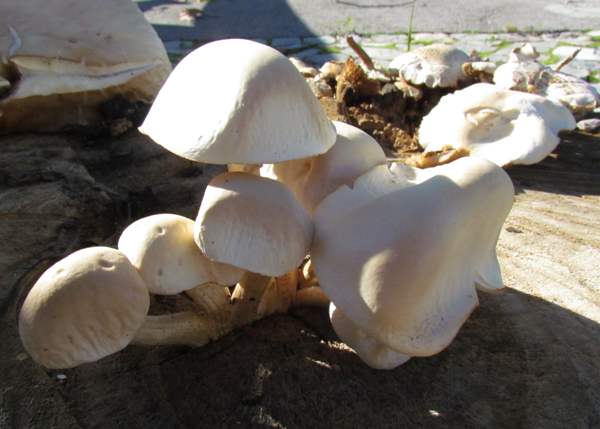
Synonyms of Cyclocybe cylindracea include Agaricus cylindraceus DC., Agaricus aegerita V. Brig., Agaricus capistratus Cooke, Agaricus leochromus Cooke, Pholiota aegerita (V. Brig.) Quél., Pholiota cylindracea (DC.) Gillet, Pholiota capistrata (Cooke) Sacc., Pholiota leochroma (Cooke) Sacc., Agrocybe aegerita (V. Brig.) Fayod, Togaria cylindracea (DC.) Romagn., and Agrocybe cylindracea (DC.) Maire.
In some field guides this mushroom is recorded in the family Bolbitiaceae rather than, as here, in Strophariaceae.
Etymology
Not all fieldcap fungi occur in open fields, and the Dark Fieldcap is definitely a mushroom of field margins, hedgerows, woodlands and other shady places near trees. 'Fieldcap' is derived from Agro-, of fields, and -cybe, head or cap, and is therefore a direct translation of the generic old name Agrocybe. The prefix Cyclo- means circular, and so Cyclocybe refers to a circular head (not to be confused with 'Roundhead', which is a general term applied to fungi of the genus Stropharia!). The specific epithet cylindracea simply means cylindrical.
Above: Very much the archetypal urban mushrooms, these Poplar Fieldcaps are busy munching the remains of an old tree stump in southern Portugal. The tree died after too many motorists collided with it, stripping away most of the bark from the base of the tree, which then had to be felled.
Identification guide
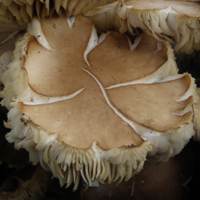 |
CapThe Poplar Fieldcap has caps 4 to10cm across when fully expanded; they are at first hemispherical, becoming broadly convex or flat and with a wavy margin; in dry weather the surface often cracks (as pictured here); pale buff, flushed mid brown towards the centre and darkening with age. Stem5 to 10cm long and 1 to 1.5cm dia.; creamy white, turning brown with age; persistent, pendent ring. |
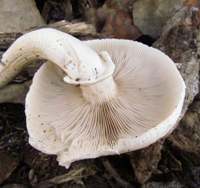 |
GillsPoplar Fieldcap gills are adnate or slightly decurrent; initially cream, turning grey-brown and later mid brown as spores mature. |
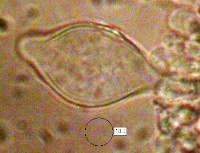 |
Pleurocystidia and CheilocystidiaThe pleurocystidia (cystidia standing out from the gill faces) and cheilocystidia (cystidia standing out from the gill edges) are quite variable, often clavate but sometimes lageniform or (as seen here) utriform. |
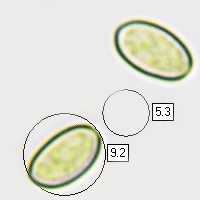 |
SporesEllipsoidal, smooth, 8.5-11 x 5-6.5µm. Spore printTobacco-brown. |
Odour/taste |
Pleasant odour; nutty taste. |
Habitat & Ecological role |
Saprobic, in tufts on poplar and willow stumps and standing dead or dying trees; also on hardwood chips used as mulch in gardens. |
Season |
July to October in Britain and Ireland; up to three months later in southern Portugal and Spain. |
Similar species |
Agrocybe praecox, which also occurs in spring and early summer, often grows in grass or in woodchip mulch; it is typically smaller and usually has a darker cap. |
Culinary Notes
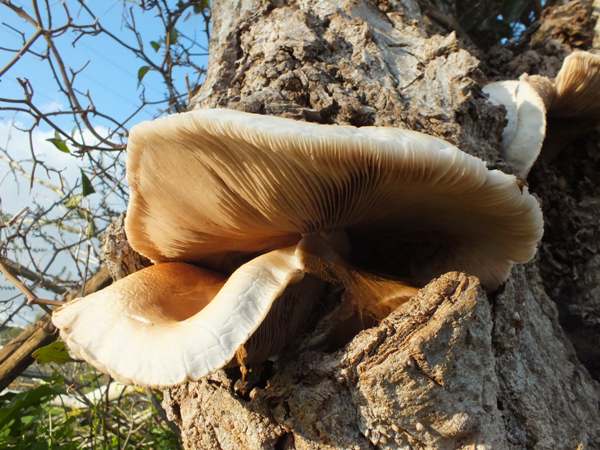
The specimens shown above are growing from a wound where a branch has been broken from a Poplar in the Algarve region of Portugal. Looking very much like edible Oyster Mushrooms, these bracket-like fruitbodies betray their true identity via the brown spores and browning gills that are characteristic of Poplar Fieldcaps. Agrocybe cylindracea is generally considered edible; however, this wood-rotting mushroom is not by any means noteworthy, and few fungiphiles in Europe seem to bother with it.
Reference Sources
Fascinated by Fungi, 2nd Edition, Pat O'Reilly 2016, reprinted by Coch-y-bonddu Books in 2022.
BMS List of English Names for Fungi
Funga Nordica: 2nd edition 2012. Edited by Knudsen, H. & Vesterholt, J. ISBN 9788798396130
Marcel Bon, 1980: Revision du Genre Agrocybe Fayod. Bulletin trimestriel de la Fédération Mycologique Dauphiné-Savoie, 76: 32-36. Bulletin de la Fédération trimestriel Mycologique Dauphiné-Savoie, 76: 32-36.
Dictionary of the Fungi; Paul M. Kirk, Paul F. Cannon, David W. Minter and J. A. Stalpers; CABI, 2008
Taxonomic history and synonym information on these pages is drawn from many sources but in particular from the British Mycological Society's GB Checklist of Fungi.
